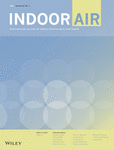Rigorous mathematical formulation of net escape velocity and net escape probability determining a macroscopic concentration
Abstract
Net escape velocity (NEV) and net escape probability (NEP) are concepts that describe that scalar quantity discharged from a source in an indoor air environment is expressed by the unique velocity scales of the returning and escaping populations. Despite the conceptual description and applications of several numerical simulations, the definitions were not precisely explained using a mathematical formula. Here, we derive rigorous mathematical formulations of the NEV and NEP. These formulations provide us with the physical interpretation of NEV, clarify the sufficient condition of perfect escape, and lead to a further formulation of the transfer probability of the scalar. To justify and apply the derived relationships, two simple problems were numerically solved: One was a diffusion equation, and the other was an advection–diffusion equation. The results of the diffusion problem clearly demonstrate that only the outgoing scalar flux exists on the surface of the control volume, covering the source at any location. In contrast, the advection–diffusion problem reveals that there is a returning population of the scalar in most locations, despite both diffusion and turbulent parts working to remove the scalar. This rigorous formulation contributes to apply NEV as an appropriate air quality index with the clear physical interpretation to determine the local scalar concentration.
CONFLICT OF INTEREST
The authors have no conflict of interest to declare.
Open Research
DATA AVAILABILITY STATEMENT
The data that support the findings of this study are available from the corresponding author upon reasonable request.




